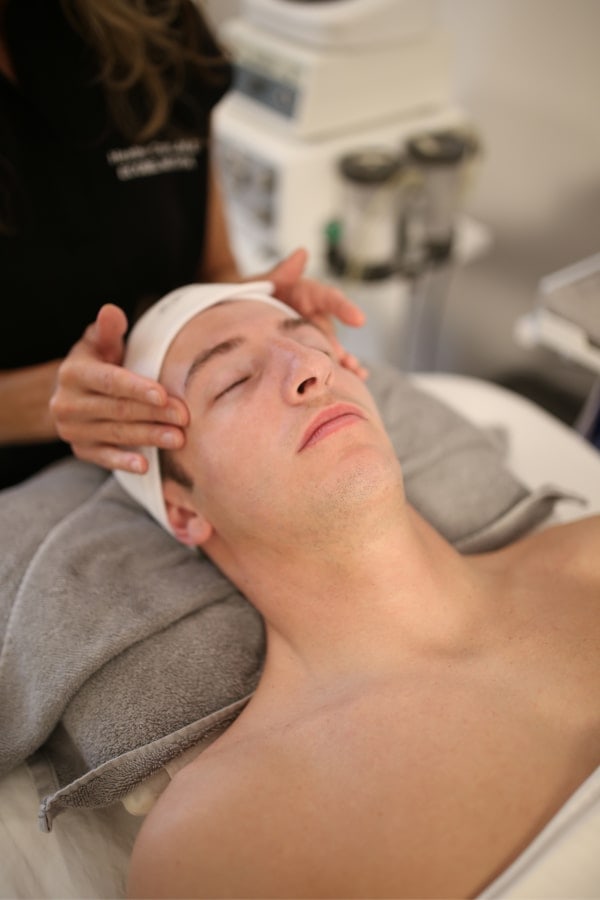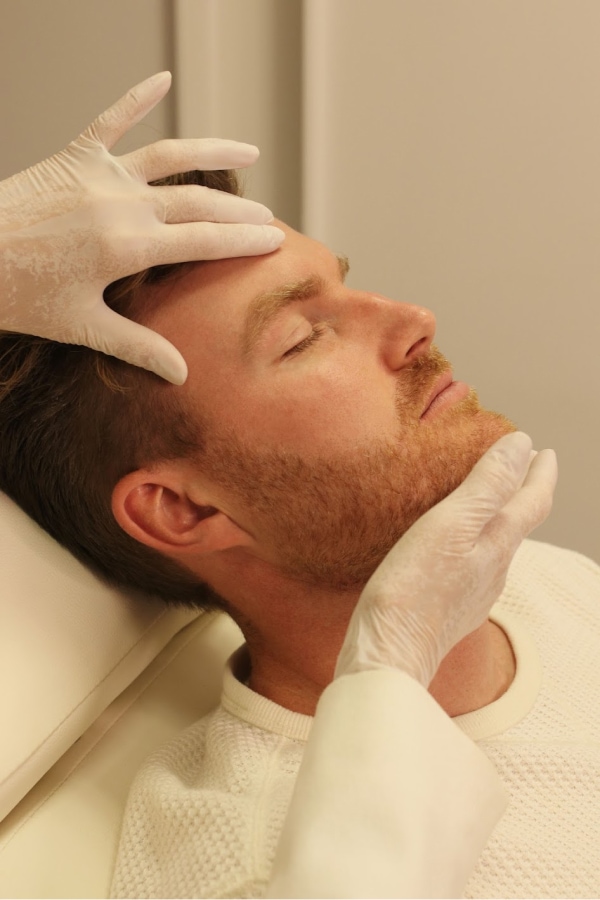Expert Chemical Peel Treatments in Atlanta for Radiant, Healthy Skin
Experience smoother, softer, and more radiant skin with professional chemical peel treatments in Atlanta. Our expert team delivers safe, customized care to rejuvenate your complexion and reveal a healthier glow.
BioRePeel – The Next Generation of Professional Chemical Peels in Atlanta
Acids for your skin? While it may sound like a skincare no-no, using exfoliating and rejuvenating acids via a chemical peel to revive your complexion is a time-tested way to improve the health of your complexion. For years, professional chemical peels have been a go-to treatment to refresh the skin quickly and provide dramatic results. However, unlike at-home exfoliating scrubs and treatments, the degree of exfoliation that can be accomplished with a professional chemical peel is far more significant with better results.
The BioRePeelCl3® BLUE is also assisted by the lipophilic phase. The synergy of the individual components of BioRePeelCl3® sheds dead skin cells, exfoliates the skin’s surface, and reveals a more youthful-looking appearance. It is manufactured according to international standards to guarantee the highest quality and 100% Italian research and innovation. This is the new frontier of aesthetic peeling.
The harmonious interplay of the individual elements in BioRePeelCl3® BLUE reinstates ideal physiological conditions for the skin, transforming the product from a typical cosmetic peel into a holistic aesthetic solution. This formulation effectively caters to a wide range of cosmetic requirements, thanks to its exfoliating, beautifying, and hydrating attributes.
With all pros and no cons, the BioRePeel is:
Safe for all skin types and all Fitzpatricks I-VI.
Safe for all ages and the whole body.
Stimulates collagen production and improves skin elasticity.
Effectively addresses issues such as acne, hyperpigmentation, texture, and enlarged pores.
Enhances skin hydration and nourishment using bi-phasic technology and delivery system to leave skin plump and revitalized.
Quick lunch time peel if done as a stand-alone service with immediate results. Leave glowing!
No photo-sensitivity! Meaning safe year-round, every season, and even in the summer!
No post-treatment signs
Multifunctional


Can Be Combined With
You can use BioRePeelCl3® in synergy with other treatments to improve its performance and results:
Hydrafacial
Microneedling
Before injectable treatments
Before LED
Before radiofrequency microneedling
What's in BioRePeel
30% Trichloroacetic Acid enhanced by an innovative and functional mixture of AHA’s, BHA’s, PHA’s, amino acids, and vitamins.
Trichloroacetic Acid 30%
Lactobionic Acid
Salicylic Acid
Tartaric Acid and Citric Acid
Glycine, Proline, Hydroxyproline, and Arginine
Vitamins C and B2
gamma-Aminobutyric Acid
Squalane
Isopropyl Myristate
Depending on what your provider suggests after a medical evaluation, the BioRePeel can be done every 7–10 days for up to 4–6 sessions to address specific skin concerns. Treatments can be performed once every 4 weeks thereafter, along with facials or other in-house services, and for general upkeep.
We recommend doing a series of 4 peels for the first 4 weeks in a row to achieve the most dramatic results. We offer a special package price of $800 for 4 BioRePeels, saving $200 compared to the original price of $1,000 per peel. Your aesthetician will recommend any post-care products and instructions after your BioRePeel treatment.
The Perfect Derma Peel
THE PERFECT DERMA™ PEEL is a medical-grade, and the ONLY medium-depth chemical peel with Glutathione that is safe and effective for all skin types & ethnicities (Fitzpatrick I-VI). The Perfect Derma Peel’s exclusive formulation provides superior results for aging skin, acne, hyperpigmentation, melasma, and other common skin concerns. See healthier, younger-looking skin results in about one week!
The application process is virtually painless and takes approximately 15 minutes, but plan on being at the med spa for 45 minutes to discuss your concerns and goals with your aesthetician, receive the treatment, and go over post-care instructions and your take-home kit. There is little downtime, with visible peeling that normally lasts two to four days.
THE PERFECT DERMA™ PEEL is the ONLY medical-grade peel on the market that contains the master antioxidant Glutathione. Glutathione penetrates deep into the cellular level of the skin to help reduce free radical damage, brighten the skin, and slow down the aging process.
We recommend doing a series of 3 peels for the first 3 months for best results, but this depends on your goal and what you and your provider agree upon. We offer special pricing for a package at $750 for 3 peels, saving $150 compared to the original price of $300 per peel, which would have been $900. We will send you home with your very own post-care kit with fully detailed instructions that are included in the pricing. Happy Peeling!

CHEMICAL PEELS
Benefits
TCA: Exfoliant, removes dead skin cells, and promotes new cell growth
Retinoic Acid: Exfoliant, stimulates cellular renewal
Salicylic Acid: Exfoliant, reduces acne bacteria
Kojic Acid: Exfoliant, offers skin brightening benefits
Phenol: Exfoliant, numbing agent
Glutathione: Antioxidant, skin brightener
Vitamin C: Antioxidant stimulates collagen production
Key Ingredients
TCA: Exfoliant, removes dead skin cells, and promotes new cell growth
Retinoic Acid: Exfoliant, stimulates cellular renewal
Salicylic Acid: Exfoliant, reduces acne bacteria
Kojic Acid: Exfoliant, offers skin brightening benefits
Phenol: Exfoliant, numbing agent
Glutathione: Antioxidant, skin brightener
Vitamin C: Antioxidant stimulates collagen production

Like a laser treatment that resurfaces the skin, chemical peels achieve the same end goal. But chemical peels rely on physical exfoliating agents instead of using heat or energy as a laser does. This results in less downtime and recovery, yet still great results. Unlike lasers, most peels are safe for various skin types and tones, but a consultation is always imperative to determine the right course of treatment for you
Chemical peels are a long-standing skin-perfecting treatment that can help improve skin issues, including:
- Rough and uneven texture
- Fine lines and wrinkles
- Acne scars
- Dark spots and hyperpigmentation
- A dull-looking complexion
- Active acne breakouts
- Decreased collagen and elastin levels in the skin
Post-peel, it’s also normal for some minor dryness or patches of skin flaking, which is simply the dead skin shedding itself from the surface. Again, keeping the skin moisturized and well-protected from the sun is essential. After a few days, any side effects from the peel should subside as the new skin emerges to the surface.
CHEMICAL PEELS
Who is a Chemical Peel Best for?
Most skin types and tones—even darker ones—benefit from a chemical peel. Discuss your skin history and other pertinent information with your aesthetician to ensure no adverse effects. And, of course, ensure they have a good knowledge of the skin and experience with the chemical peel you are doing.
Specific skin issues tend to respond better to a chemical peel than others. For example, if you are experiencing any of the concerns below, then a chemical peel may be the proper treatment for you:
Dullness
Discoloration and hyperpigmentation
Breakouts
Acne scars
Oily skin
Fine lines and wrinkles
CHEMICAL PEELS
The Results
With a chemical peel, you can expect to improve skin tone, texture, and specific skin conditions. Removing the skin’s outermost layer helps to erase signs of damage and uneven pigmentation by revealing smoother, fresher skin underneath. The most common results of a chemical peel include the following:
Smoother skin that’s healthier
Fewer lines and wrinkles
Better skin tone and texture
Fewer breakouts and acne scars
Improvement of age spots and hyperpigmentation
While the results of a chemical peel can be seen on the face, particular features, including around the mouth, eyes, and even the nose, tend to bear most of the improvement. Plus, as the peel works to even out the skin, it appears softer and more radiant, with less discoloration and fewer spots. Those who suffer from acne breakouts and scarring are likely to see fewer clogged pores and improvement in their pimples and scars.
Of course, the results of a chemical peel depend on your skin type and tone, the issues at hand, and the type of peel used. However, any changes seen in the skin are not permanent and require maintenance with repeat peels as needed. In addition, each peel’s results differ in longevity, which on average lasts from a few weeks to a few months to up to one year, depending on your skincare habits.
The Different Types of Chemical Peels
Not all chemical peels are created equal; some are more potent than others. Plus, only some benefit from the strongest type of peel available, which is why a consultation is of the utmost importance.
Stronger peels feel more intense on the skin. Regardless of their intensity level, most chemical peels have some tingling sensation—some can even feel like the skin is stinging slightly or spicy. However, acids in buffered chemical peels shouldn’t cause discomfort on the skin. And once the peel is neutralized, the skin should feel completely normal.
Superficial or light peels usually rely on an alpha-beta hydroxy acid (AHA) or beta hydroxy acid (BHA) like salicylic, lactic, or glycolic acid to provide subtle results with little to no downtime. They are compatible with most skin types and are often used to correct mild acne, sun damage, dull and dry skin, wrinkles, and hyperpigmentation.
Most medium-strength chemical peels utilize trichloroacetic acid (TCA) to correct and treat blemishes and acne, as well as post-breakout pigmentation and scarring, and even fine lines. These are more powerful than a lighter peel and can cause more extreme peeling and dryness.
The most potent type of chemical peel, deep peels harness the power of phenol to exfoliate the skin deeply. Most patients who undergo a deep phenol chemical peel only have one done in their lifetime. The peel is so intense that it requires anesthesia and is performed by a doctor, usually at the same time as a facial procedure like a facelift.
The Benefits of a Chemical Peel
The acids in a chemical peel work well to lift away dead skin cells, boost collagen, create younger-looking skin, tighten the skin, and speed up cell turnover. Chemical peels are also fantastic for cleaning out the pores so that breakouts are less frequent. Peels remain one of the best skin clarifying and rejuvenating treatments since they clear the skin of these dead skin cells. Just about anyone can benefit from a chemical peel.
The primary benefits of routine chemical peels include improving skin conditions such as the following:
- Breakouts and acne
- Acne scars and other scars
- Hyperpigmentation and discoloration
- Sun damage
- Uneven skin tone and texture
- Wrinkles and fine lines
- A dull complexion
While chemical peels can be used on the face and body, it’s important to note that the skin benefits will vary depending on the acids and type of peel used. Treatment with a qualified and expertly trained aesthetician and a consultation will help you determine the best chemical peel for your skin needs.

CHEMICAL PEELS
How Much Does a Chemical Peel Cost?
Every patient is different, so what benefits one skin type may not work as well for another. To determine the best peel for your skin, we recommend a consultation with our experienced team of skin experts and medical providers to discuss the treatment with you further and determine if a chemical peel is right for you.
The chemical peel is tailored to your needs, which is why the cost varies, although our chemical peels start at $200. Our team can customize a skin package to help you obtain the desired results. A consultation with our staff will ensure more accurate pricing.
Chemical peels
Common FAQs
Everyone has different skin and needs, so a consultation is preferred to determine what benefits your skin the most. In comparison, some patients need just one peel, while others require a series of peels to reap the maximum benefits.
No matter what chemical peel you get, avoiding the sun at all costs is vital. Sun exposure can cause inflammation within the skin, leading to discoloration, hyperpigmentation, prolonged healing, and potential scarring. Therefore, it’s best to avoid the sun for at least two weeks, if not longer, and wear sunscreen daily.
Avoid using exfoliating acids or any exfoliating cleanser or scrub for at least one week after your peel, if not longer.
No! No matter what, let the skin exfoliate at its speed and follow its natural course. Picking or peeling at shedding and flaking skin, or even trying to get the skin off with exfoliators, can lead to unwanted hyperpigmentation.
The face is the most commonly treated area for peels, but they are also effective for improving the tone and texture of the skin on the neck, hands, and chest.
It’s normal for the skin to appear red and even be sensitive after a peel, which can take 30 to 60 minutes, depending on what other treatments are performed. After the peel, you can return to your normal activities, although you may want to avoid exercising and saunas and hot baths, which can cause heat to be produced within the skin. If there’s slight peeling or redness, it can be mitigated with a good moisturizer and some concealing makeup. You may see some improvement in the first few days after the peel, which will continue to improve over the following week.
Unlock Your Skin's Potential at Ecobel Med Spa
If you’re ready to achieve smooth, flawless skin, look no further than Ecobel Med Spa. Our team of internationally trained, skilled estheticians and skin care specialists has 40 years of experience in the beauty industry. They will work with you to determine the best chemical peel plan for your skin’s needs. Don’t wait to get the healthy, glowing, youthful skin you deserve. Book your consultation for chemical peel treatment today!
